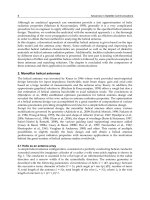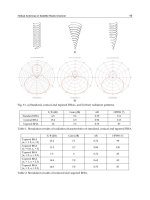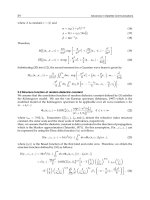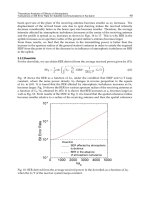Advances in Satellite Communications Part 8 pptx
Bạn đang xem bản rút gọn của tài liệu. Xem và tải ngay bản đầy đủ của tài liệu tại đây (811.23 KB, 15 trang )
12 Will-be-set-by-IN-TECH
GSAKMP operates under the assumption there is at least one PKI (Public Key Infrastructure)
for the group to trust. GSAKMP relies on such PKI while creating and verifying security
policy rules. The public key of the GO must be known in advance to all GMs.
Upon creation of a new multicast group, the GO starts the process with the creation of a Policy
Token (PT) describing the rules for access control and authorizations for that group. The token
is signed by the GO. The token contains:
•identiſcation for the PT and group;
• access control rules dictating who can have access to the group keys;
• authorization rules stating who can be a SGCKS;
• mechanisms for handling security, e.g. Security Protocol, Key Creation Method, Key
encryption algorithm, Signature, etc.
After a PT is created and signed, it is sent by the GO to a potential GCKS. The latter veriſes
the signature and, based on the rules speciſed in the PT, decides whether it can act as a GCKS
for the new group. If it can, then the new group is established and all GMs have to register
with the GCKS (see Fig. 5). Upon receiving each registration request, the GCKS veriſes the
signature of the requesting GM and checks whether it is authorized to join the group. If the
checks succeeds, the GM receives a "Key download" message. On its part a GM has to verify
the GCKS has the authority to manage the group. Eventually, by using the information in the
message, a GM can set up bo th REKEY a nd DATA SAs. If the GM has no need to send data to
the group and it is planning to act as a receiver only, it w ill have no need to send a "Request to
join" message and the "Key download" message is simply sent to the GM after its registration.
Controller Member
Request To Join
Shared Keyed Group Session
Noti#cation - ACK/NACK
Key Download (Policy Token)
Fig. 5. GM registration in GSAKMP (from (Harney et al., 2006))
A rekeying is required whenever a GM joins or leaves the group and such operation will
involve the GO. The l atter is informed about node changes and reacts by creating a new PT.
PTs must be pushed to the GCKS and the S-GCKS. Upon receiving a PT the GCKS nodes
have to check whether the changes involve their own GMs. With no changes, the PT will
be distributed according to t he LKH by the use of the group key. If some of their nodes has
changed than each client must receive the new PT and the only way to do it safely is to encrypt
it according to the chosen GKMA and to send everything to every client.
94
Advances in Satellite Communications
Multicast Security and Reliable Transport of Rekey Messages over Hybrid Satellite/Terrestrial Networks 13
2.4.2 Group Domain of Interpretation protocol
With reference to the ISAKMP ( Maughan et al., 1998) terminology, GDOI (Baugher et al.,
2003) speciſes a domain of interpretation for group key management. While the ISAKMP
speciſcation is no longer current (being obsoleted by IKEv2 (Kaufman, 2005)), part of its
framework is still used to detail the GDOI speciſcations.
The setup of secure connections is the result of a two-phases procedure in ISAKMP (and in
GDOI). In our terms, the ſrst phase allows to establish a secure unicast connection between
the clients and the GCKS. Phase 2 is dedicated to rekeying and the creation of DATA SAs.
Identities of the involved entities are known (together with authorizations) to the GCKS from
phase 1 but they can be integrated with certiſcates provided by the GO in phase 2.
Keys can be transmitted with two formats: GROUPKEY-PULL and GROUPKEY-PUSH. The
ſrst one is used by a GM in a client-server fashion to ask for TEKs, KEKs or KEKs arrays (with
LKH) according to its needs.
On the o ther hand, GROUPKEY-PUSH is used by the GCKS when it needs to force the update
of the REKEY SA or of the DATA SA.
2.4.3 Multimedia Inter KEYing protocol
The IETF WG has shown a deſnite interest in the protection of real-time trafſc. In particular,
the key exchange for SRTP (Secure Real-Time Transport Protocol) has been considered. The
MIKEY protocol’s design is the result of such focus. It is of use both in one-to-one and in
one-to-many exchanges.
The MIKEY (Arkko et al., 2004) pr otocol speciſes key management functionalities. It
simpliſes the architecture by allowing the sender to incorporate the functions of the GCKS.
The Group Control part of the operations, the user’s authentication, is performed throughout
the course of the initial key exchange by signed messages. The protocol’s emphasis on
real-time data is represented by its efforts to provide a lower latency, its consideration for
the usage over heterogeneous networks and for small groups’ interactive exchanges.
The distribution of TEKs is based on the use of either shared keys (distributed in advance) or
public keys encryption. With such methods the Trafſc Encryption Key Generation Key (TGK)
is a shared information between all hosts participating the session. Difſe-Hellman is used
for one-to-one connections instead. In this case each client connects to the source (or to the
separate GCKS node) and the TGK is different for each GM - GCKS pair.
To avoid the problems associated with the advance distribution of the shared keys, the use
of certiſcates signed by a trusted CA can be preferred. Procedures for rekeying are not
deſned in MIKEY (the protocol is supposed to be run each time the rekeying is needed).
MBMS (Multimedia Broadcast / Multicast Service) (3GPP, 2006) is an extension to the protocol
designed to allow multicast rekeying in certain environments.
3. Reliable multicast
The topic of the reliable transport of multicast trafſc has been already anticipated in par. 2.2.4,
especially with reference to the classic problem of feedback implosion. Here we’ll present
three candidate protocols for the reliable multicast transport of encryption keys.
While protocols based on FEC do generally p erform better (Setia et al., 2002) we wish to draw
the attention to the fact that in a satellite environment, where the noise tends to be bursty and
often a return channel is missing, a protocol simply transmitting multiple copies of the rekey
messages might offer a viable alternative.
95
Multicast Security and Reliable Transport of
Rekey Messages over Hybrid Satellite/Terrestrial Networks
14 Will-be-set-by-IN-TECH
The three protocols we wish to present are Pragmatic General Multicast (PGM) (see par. 3.1),
NACK-Oriented Reliable Multicast (NORM) (see par. 3.2 ) and our SRDP-Sign (see par. 3.3)
3.1 Pragmatic General Multicast (PGM)
”Pragmatic General Multicast (PGM) is a reliable transport protocol for applications that
require ordered or unordered, duplicate-free, multicast data delivery from multiple sources
to multiple receivers” (Speakman et al., 2001).
The protocol, developed by a large team of researchers, has the RFC status of "Experimental"
as of this writing. Its design puts emphasis on simplicity and does not support much more
than the essential capabilities for this class of protocols. Its main concern is the reduction of the
repair trafſc (driven from NACK implosion or caused by the useless feeding of redundancy
to receivers not needing it).
For better operation PGM needs support from the routers crossed by the multicast trafſc. That
is each router should run PGM-aware software (or ſrmware) extensions (or, put in different
terms, be a PGM NE or PGM-capable Network Elements). At any rate, the protocol can also
work, although less efſciently, when some or all of the routers are unaware of it.
PGM runs over the standard IP multicast. As customary with that protocol, GMs can join and
leave the group without notifying the source. The o nly guarantee for a GM is that, once joined
the group, it will receive the data with no errors. Any GM can become an independent sender
for the group it belongs to and its identiſcation is given by a Transport Session Identiſer
that no one else can share. PGM is ƀexible enough to support many different types of
applications "as disparate as stock and news updates, data conferencing, low-delay real-time
video transfer, and bulk data transfer". Other supplementary options include Designated
Local Repairer (DLR) support, fragmentation, late joining, and Forward Error Correction
(FEC).
The protocol gets its feedback about the transmission results in the form of NACKs. The
potential danger of a NACK implosion is reduced by NACK suppression and NACK
aggregation in PGM NE routers (see below).
PGM deſne the following type of packets:
• ODATA, the Original copy of the transmitted DATA;
• NAK, a Negative AcKnowledgement issued when the receiver realizes a packet is missing
in the sequence it received;
• NCF, NAK Conſrmation;
• RDATA, a Retransmission of the original DATA;
• SPM, Source Path Message.
3.1.1 P GM transmit window
Mimicking the strategies followed by unicast reliable protocols, PGM keeps a sliding window
within which to transmit data. The absence of data allowing to accurately shift the left side of
the window leads to the use of a few expedients (based on ſxedtimewaits,onagivenperiod
without received NAKs etc.).
3.1.2 PGM tree
To forward data to the intended recipients, PGM builds its own distribution tree (PGM
tree) which is identical to the distribution tree natively built by the routers supporting the
96
Advances in Satellite Communications
Multicast Secur ity and Reliable Transport of Rekey Messages over Hybr id Satellite/Terrestr ial Networks 15
IP multicast protocol when all such routers are PGM NE. More generally, PGM builds the
distribution tree (the "overlay network") over the original IP multicast tree by having the
sender transmitting Source Path Messages (SPM) to the group at regular intervals during the
data transfer.
FROM SOURCE
PGM
NE
1
PGM
NE
2
Receiver 1
Receiver 2
Receiver 3
PGM
NE
3
UPSTREAM
DOWNSTREAM
Fig. 6. PGM upstream/downstream attributes for router PGM NE2
SPMs are modiſed at each crossed PGM NE (see Fig. 6). When it reaches a PGM NE an SPM
packet contains the address of the PGM NE it comes from. B efore forwarding the packet, a
PGM NE substitutes its own address to that address so that every PGM NE will always know
the address of its upstream closest PGM NE (Gemmell et al., 2003).
When ODATA packets start to ƀow and a host detects a missing packet, after a random backoff
time it sends a NAK to the upstream PGM NE it knows because of the above procedure. On
its turn, the latter:
• sends back a multicast NCF packet by the interface that received the NAK;
• forwards to the PGM NE upstream the same NAK packet it received and receives an NCF
from it.
The process continues upstream until the source or a DLR is reached. When the NAK reaches
the source or a DLR, these may re-send the lost packet downstream to the multicast group,
either in the original form or by some FEC encoding.
3.1.3 Local repair: DLR
If no DLR were present, all the repair packets had to be re-sent by the source. The presence
of DLRs helps to reduce the outgoing trafſc at the source and to limit it to the multicast tree
97
Multicast Security and Reliable Transport of
Rekey Messages over Hybrid Satellite/Terrestrial Networks
16 Will-be-set-by-IN-TECH
portion downstream the DLR. It also helps to speed the repair procedure. DLR can announce
their presence so that PGM NEs can direct NAKs to them rather than to the source.
3.1.4 P GM with non-PGM-aware routers
PGM can operate even when all routers are not PGM-aware. Of course, with no PGM NE,
many of the features of the protocol are lost. For example, each NAK packet will be multicast
in the usual way, without the suppression of duplicated NAKs. It will be also impossible to
perform efſcient repairs, since RDATA packets will be transmitted again and again, no matter
how many GM have requested t he same packet. The protocol performances will ho wever
improve as the number of PGM NE increases.
3.1.5 Congestion c ontrol
Congestion control in PGM is performed by limiting the transmission rate at the source. Such
limitation is based on the feedback received both from receivers and from PGM NEs. The
feedback is given by appending special "report" ſelds at the end of a NAK packet. The reports
communicate the "load" measured by receivers, in the form of packet loss rates, or by PGM
NEs, in the form of packet drop rates.
The feedback can be of three different types:
• worst link load as measured by the PGM NEs;
• worst end-to-end path load as measured by the PGM NEs;
• worst end-to-end path load as reported by receivers.
Although congestion control is mandatory, there is no speciſcation of how this data should
be used to adjust the sending rate and the choice is left to the i mplementation (Gemmell et al.,
2003).
An extension of the protocol aimed at congestion control has been proposed with PGM CC
(Rizzo, 2000). PGMCC is described as "single rate" in that "all receivers gets the same rate
and the source adapts to the slowest receiver" and "TCP-friendly" in that the sender tries not
to transmit faster than the rate allowed by TCP speciſcations with the slowest receiver. The
protocol adopts a window-based, TCP-like control loop.
3.2 Negative-A CKnowledgment (NACK) Oriented Reliable Multicast (NORM)
According to (Adamson et al., 2009) Th e Negative-ACKnowledgment (NACK) Oriented
Reliable Multicast (NORM) protocol "can provide reliable transport of data from one or more
senders to a group of receivers over an IP multicast network". Efſciency, scalability, support
for heterogeneous IP networks and for bulk transfers are said to be the goals for the protocol’s
design. Another interesting target for the protocol is to provide "support for distributed
multicast session participation with minimal coordination among senders and receivers".
Starting with (Adamson et al., 2009), NORM is on the IETF standard track. In (Adamson et al.,
2009) message types and protocol operation are explained in detail. (Adamson et al., 2008)
discusses goals and challenges for reliable multicast protocols in general, deſnes building
blocks to address these goals and gives a rationale for the development of NORM.
End-to-end reliable transport of application data is based on the transmission of NACKs
from the receivers to initiate repair transmissions from the senders. Variability in network
conditions is taken care of by using adaptive timers for the protocol operations. The protocol
is designed to offer its transport services to higher levels in a number of ways in order to
satisfy the needs of different applications.
98
Advances in Satellite Communications
Multicast Secur ity and Reliable Transport of Rekey Messages over Hybr id Satellite/Terrestr ial Networks 17
NORM uses FEC in various ways. It can use it both in the encoding of the original
stream and i n the repair trafſc sent to the group in response to NACKs from the receivers
(proactive/reactive FEC). In general, the more FEC redundancy is put in the original stream
the less NACKs will be received.
Most of the potential limitations of the scalability of the protocol come from the negative
feedback generated from receivers. NORM uses a probabilistic suppression of the feedback
based on exponentially distributed r andom backoff timers. To avoid disturbing the operations
of concurrent transport protocols (e.g. TCP) a congestion control scheme is speciſed, although
alternative choices are left to the implementers.
3.2.1 NORM building blocks
NORM is conceptually divided in three main blocks:
• NORM Sender Transmission, which takes care of data transmissions and reception of
feedback (NACK) messages;
• NORM Repair Process, which processes the feedback information and tells the ſrst block
what to retransmit;
• NORM Receiver Join Policies, relates to policies and procedures involving receivers
admission to the data distribution. While receiver joins are generally unconstrained, a
sender might wish to limitate the number of potential NACK senders in various ways.
Other functions (congestion control, error correction etc.) are delegated to further modules.
3.2.2 NORM operations
Messages in NORM are basically divided in sender messages and receiver messages:
NORM_CMD, NORM_INFO, and NORM_DATA message types are generated by senders
of data content NORM_NACK and NORM_ACK messages generated by receivers within a
session.
The NORM_DATA messages are used by senders to transmit application data and FEC
encoded repair packets while NORM_NACK messages are generated by receivers to
selectively request the retransmission of missing content. NORM_CMD messages are used for
various management and probing tasks while NORM_ACK is the acknowledgement message
for such commands.
As it is customary in this class of protocols, the receivers schedule random backoff timeouts
before sending a NORM_NACK message, which could be r epeated if the hoped-for repair has
not come. The sender doesn’t react to single NACK messages but rather tries to aggregate a
number of them to decide how much to "rewind" its transmission. When it deems the rewind
to be sufſcient, it proceeds to the actual retransmission.
3.2.3 Congestion c ontrol
Congestion control for NORM i s described in (Adamson et al., 2009). It is an adaptation o f
the TCP-Friendly Multicast Congestion Control (TFMCC) described in (Widmer & Handley,
2006). It is essentialy based on a rate-control approach rather than on the control of the
transmission window. The protocol speciſcation leave, freedom to opt for a window-based
approach like that of PGMCC.
99
Multicast Security and Reliable Transport of
Rekey Messages over Hybrid Satellite/Terrestrial Networks
18 Will-be-set-by-IN-TECH
3.3 Satellite Reliable Distribution Protocol for Signaling (SDRP-Sign)
The Satellite Reliable Distribution Protocol (SRDP) protocols (Tommasi et al., 2006) (Tommasi
et al., 2003) are reliable transport protocols designed with special attention to the use in
satellite applications. SRDP-Sign can be seen as an extension of the original SRDP protocol.
The two protocols use the same UDP port and implement two different types of transports:
SRDP-Bulk and SRDP-Sign. The ſrst one is FEC-based and it is used for bulk data transfers.
The second one is of the multi-send type (Tommasi et al., 2008) and has been originally
designed for signaling. Despite the original design focus of SRDP-Sign has been the use
with short messages (e.g. in multicast control applications) or more generally, with signaling,
its relative immunity to burst errors makes it interesting in the context we are examining
(Tommasi et al., 2009). One more reason of interest for the protocol is its capability to transmit
information to users who can receive information from a satellite but do not possess a return
channel. However reliability of transmissions cannot be assured with this s ubset of users.
For all other users, SRDP-Sign is capable of accepting a return feedback both via satellite and
terrestrially. The SRDP-Sign protocol is also optimized for a high number of users.
3.3.1 SRDP-Sign: Requirements and architecture
The requirements of the SRDP-Sign protocol are:
• high degree of scalability;
• fast delivery of messages;
• high resistance to burst errors;
• high probability of complete delivery of transmitted data for all users;
• guarantee of complete delivery of transmitted data for users with a return channel;
• limited use of control messaging between sender and receivers.
The objective of each session of the SRDP-Sign is to transmit messages M to R users.
Reliability is ensured via transmission of N multiple copies of the messages (Setia et al., 2002).
The SRDP-Sign protocol manages the transmission of a single message (SRDP-sign session).
The protocol can transmit multiple simultaneous sessions, that is the transmission of the
copies of two different sessions to be interlaced. Bundling more messages within a packet
is not permitted (see Fig. 7). This preserves the simplicity of packet management.
3.3.2 SRDP-Sign operations
SRDP-Sign ensures reliability of the transmission of a message M, replicating it in N packets.
P
i
is the i-th reply in the N packets sequence. The delivery of a message is organized in two
phases. During the Winding phase, the sender is restricted to replicate the message and there
is no control. During the Unwinding phase, the sender makes an estimate of the number
of receivers who did not receive the packet during the Winding Phase through a scheme of
suppression of the number of receivers.
SRDP-Sign messages can be of the following types:
• DATA,adatapacket;
• ABORT, sent to interrupt an ongoing session;
• STAT_REQ, a request to the receivers of a feedback about the correct reception of the
message;
100
Advances in Satellite Communications
Multicast Secur ity and Reliable Transport of Rekey Messages over Hybr id Satellite/Terrestr ial Networks 19
• STAT_REP,theanswertoaSTAT_REQ.
During the Winding Phase the sender transmits N copies (DATA) of the message M.In
case of a correct reception of a packet, a receiver ignores all other packets of that message.
The replicated packets are transmitted with exponential times that reduces the effects of the
potential burst errors (Tommasi et al., 2003).
During the Unwinding Phase the sender multicasts a STAT_REQ to check whether the R
receivers have received the message during the previous phase. This request is processed by
the receivers through an algorithm of probabilistic suppression of the NACKs. This behavior
has a high level of scalability (Nonnenmacher & Biersack, 1998). If a receiver sees the request
and has not received the message, then the probabilistic suppression comes into play and if it
results in an authorization to proceed, the receiver sends a STAT_REP to the source. A session
ſnishes when the last STAT_REQ message in the s equence (see below) gets no answer. On the
other hand, as soon as a STAT_REP message is received by the source, it stops the sending of
STAT_REQ messages and proceeds to a new Winding Phase.
The ABORT message, when needed, is also repeated in a ſxed way (exactly t en times at
regular intervals).
time
Fig. 7. Transmission of multiple messages (M1 and M2 cannot be interlaced)
3.3.3 Scalable Feedback Suppression (SFS)
Ideally, after transmitting a packet, the sender would like to receive boolean information
(yes/no) related to the correct reception from all the receivers. In order to prevent NACK
implosion, the Scalable Feedback Suppression (SFS) algorithm causes the random selection
of a subset of all the receivers. Such subset is allowed to transmit a negative feedback to the
sender. Obviously, only the receivers with a return channel can participate to the selection.
The algorithm begins with the selection of an high number H (which represents a very
rough and imprecise estimate of the number of potential receivers). The ſrst STAT_REQ
transmission is executed and the value probability P
H
of 10
r
(where r = −log
10
H)is
included in the message. A receiver that did not receive the original message is authorized to
reply only if it generates a pseudorandom value (between 0 and 1) and such value is lower
101
Multicast Security and Reliable Transport of
Rekey Messages over Hybrid Satellite/Terrestrial Networks
20 Will-be-set-by-IN-TECH
than P
H
. If the sender receives even a single NACK, it will abort the Unwinding phase and
will re-initiate the Winding Phase (see Fig. 7). If, on the contrary, it does not receive any
NACK, the sender iterates the STAT_REQ transmission putting in the message a value of P
H
of 10
r+1
. If the sender does not receive any NACK it increases the transmitted P
H
value until
it reaches 1. At this point it determines the message has been correctly received by everyone.
4. Performance evaluation
We set up an experimental network to test the performances of the PGM, NORM and
SRDP-Sign protocols in different scenarios. Given the scope of the present chapter only
a sample of the tests results are reported. The complete results will be the object of a
forthcoming publication.
For PGM we selected OpenPGM, an open source implementation available at (OpenPGM,
2011). OpenPGM it is not yet a ſnal release. The source code of a NORM implementation is
available at (NORM, 2007).
The network topology we employed in our test is characterized by an (hybrid) asymmetric
connectivity where a single sender is connected directly to the s atellite uplink (1Mbit/s) and
a small multicast group of receivers has a unicast terrestrial return path to the sender. In this
topology, receivers have no access to the satellite uplink but, as it is usually the case, they can
receive from the downlink either through a satellite receiver connected to their LAN or by an
on-board card (see Fig. 8). The ro und trip time is about 600ms. We also considered a scenario
in which there is no return path to the sender and therefore no kind of feedback is sent by the
receivers.
We evaluated the performances of the protocols for various packet loss percentages at the
receivers caused by the satellite link. The test is conducted in an homogeneous network
with all receivers experiencing the same percentage of independent losses. The packet loss
is emulated using Dummynet (Carbone & Rizzo, 2010).
Protocol Parameter and value Meaning
NORM blocksize=64 Number of source packets per FEC coding block.
NORM parity=32 Number of FEC parity packets.
NORM auto=32 Number of proactively parity packets.
NORM unicastNacks NACK sent in unicast.
OpenPGM Transmission Group size = 64 Number of source packets per FEC coding block.
OpenPGM Proactively parity = 32 Number of proactively parity packets.
SRDP-Sign N=3 number of replies for each message.
Table 1. Conſguration Parameters
Protocols conſguration parameters used for the present selection of the results are shown in
table 1. To put the three protocols on a par, no PGM-aware router has been employed.
We calculated the Average Key Delivery Ratio (AKDR) and the data overhead to evaluate
the performances of the above reliable multicast protocols. AKDR is the ratio {number of
keys received}/{number of keys transmitted} averaged over all multicast group members.
Data overhead is the ratio {total amount of data transmitted}/{net amount of keys data
transmitted}.
Fig. 9a sh ows the results of the tests when a return channel is available, that is the receivers
are able to send a feedback to the sender. Fig. 9b shows the results with no return channel
available. Despite its simplicity and limited efſciency, it is interesting to note the fairly good
102
Advances in Satellite Communications
Multicast Secur ity and Reliable Transport of Rekey Messages over Hybr id Satellite/Terrestr ial Networks 21
LAN
LAN
Internet terrestre
SsS
Up-link
Down-link
Down-link
Down-link
Down-link
Receiving path
Receiving path
Receiving path
Receiving path
Reaching
path
Return path
Sr
1
Sr
M
Sr
R
Sr
M-1
R
1
R
M
R
M-1
R
R
Fig. 8. Test network topology
performances of SRDP-Sign with high packet losses. Increasing redundancy to compensate
for high error rates, generally tends to favour the efſciency of FEC based protocols as
compared to t hat of the replica-based ones. However, as our preliminary results suggest,
bursty environments (like the satellite ones) tend to level the comparison.
Fig.10 shows a somewhat expected outcome: since SRDP-Sign sends a ſxed number of
replicas in the winding phase, no matter how much noisy the transmission is, its overhead
is by far the largest at low levels of packet losses. On the other hand, when the level of
losses increases, also PGM and NORM are forced to retransmit packets, ending up i n reaching
approximately the same amount of overhead as SRDP-Sign.
5. Conclusions
This chapter introduced the framework and the protocols IETF speciſed for a multicast
security architecture. Three different protocols for key exchange (registration and rekeying),
have been presented: GSAKMP, MIKEY, and GDOI. They were developed with different
settings in mind, since a single protocol was not believed to be able to support all the typical
scenarios in multicast security. LKH is used to allow the rekeying p hases to efſciently scale
over a large number of users. If the keys are sent via multicast, which is common for large
groups and unavoidable with satellites, a reliable multicast transport is required. Three
protocols offering such service have been considered: PGM, NORM and SRDP-Sign. The
ſrst two of them have been debated within the IETF MSEC WG. The third one was originally
conceived for the utilization in multicast signaling (i.e. the reliable delivery of short control
103
Multicast Security and Reliable Transport of
Rekey Messages over Hybrid Satellite/Terrestrial Networks
22 Will-be-set-by-IN-TECH
(a) Receivers with a return path
(b) Receivers without return path
Fig. 9. Average Key Delivery Ratio
104
Advances in Satellite Communications
Multicast Secur ity and Reliable Transport of Rekey Messages over Hybr id Satellite/Terrestr ial Networks 23
Fig. 10. Data Overhead (receivers with a return path)
messages). However its promising behavior in a satellite environment has prompted to
test it in the present context. The preliminary results suggest that, while PGP and NORM
do generally perform better, high levels of packet losses (which are typical of the bursty
disruption of satellites transmissions) tend to put the simpler approach of SRDP-Sign in a
more favorable position.
6. References
3GPP (2006). Security of Multimedia Broadcast / Multicast Service (MBMS). Technical
speciſcation TS 33.246.
Adamson, B., Bormann, C., Handley, M. & Macker, J. (2008). Multicast
Negative-Acknowledgment (NACK) Building Blocks, RFC 5401. Obsoletes
RFC3941.
Adamson, B., Bormann, C., Handley, M. & Macker, J. (2009). NACK-Oriented Reliable
Multicast (NORM) Transport Protocol, RFC 5740. Obsoletes RFC3940.
Arkko, J., Carrara, E., Lindholm, F., Naslund, M. & Norrman, K. (2004). MIKEY: Multimedia
Internet KEYing, RFC 3830. Updated by RFC 4738.
Arslan, M. G. & Alagöz, F. (2006). Security issues and performance study of key management
techniques over satellite links, Proceedings of CAMAD.
Balenson, D., McGrew, D. & Sherman, A. (2000). Key Management for Large Dynamic
Groups: One-Way Function Trees and Amortized Initialization, Internet Draft (work
in progress), draft-irtf-smug-groupkeymgmt-oft-00.
Baugher, M., C anetti, R., Dondeti, L. & Lindholm, F. (2005). Multicast Security (MSEC) Group
Key Management Architecture, RFC 4046.
Baugher, M., Weis, B., Hardjono, T. & Harney, H. (2003). The Group Domain of Interpretation,
RFC 3547.
Carbone, M. & Rizzo, L. (2010). Dummynet revisited, Computer Communication Review
pp. 12–20.
105
Multicast Security and Reliable Transport of
Rekey Messages over Hybrid Satellite/Terrestrial Networks
24 Will-be-set-by-IN-TECH
Cruickshank, H., Evans, B., Mertzanis, I., Leitold, H. & Po sch, R. (1998). Securing multimedia
services over satellite atm networks, International Journal of Satellite Communications
pp. 169–208.
Deering, S. (1989). Host extensions for IP m ulticasting, RFC 1112. Obsoletes RFC 988, RFC
1054, Updated by RFC 2236.
Deering, S. (1991). Multicast Routing in a Datagram Internetwork, Ph.D. Thesis.
Diot, C., Levine, B., Lyles, B., Kassem, H. & Balensiefen, D. (2000). Deployment issues
for the ip multicast service and architecture, IEEE Network magazine special issue on
Multicasting pp. 78–88.
Dondeti, L. R., Mukherjee, S. & Samal, A. (1999). Survey and comparison of secure group
communication protocols, Technical report, University of Nebraska-Lincoln.
Eriksson, H. (1994). Mbone: the multicast backbone, Communications of The ACM pp. 54–60.
Eskicioglu, A. M. (2003). Multimedia security in group communications: Recent progress
in management, authentication, and watermarking, ACM Multimedia Systems Journal
pp. 239–248.
Gemmell, J., Montgomery, T., Speakman, T., Bhaskar, N. & Crowcroft, J. (2003). The pgm
reliable multicast protocol, Technical report, IEEE Network.
Hardjono, T., Baugher, M. & Harney, H. (2001). Group security association (gsa) management
in ip multicast, Proceedings of SEC.
Hardjono, T. & Weis, B. (2004). The Multicast Group Security Architecture, RFC 3740.
Harkins, D. & Carrel, D. (1998). T he Internet Key Exchange (IKE), RFC 2409. Obsoleted by
RFC 4306, updated by RFC 4109.
Harney, H., Colegrove, A., Harder, E., Meth, U., & Fleischer, R. (2003). Tunneled Group
Secure Association Key Management Protocol, Internet Draft (work in progress),
draft-ietf-msec-tgsakmp-00.
Harney, H. , Meth, U., Colegrove, A. & Gross, G. (2006). GSAKMP: Group Secure Association
Key Management Protocol, RFC 4535.
Howarth, M. P., Iyengar, S., Sun, Z. & C ruickshank, H. (2004). Dynamics of key management
in secure satellite multicast., IEEE Journal on Selected Areas in Communications
pp. 308–319.
ISO 7498-2 (1989). Information processing systems, Open Systems Interconnection Basic
Reference Model, Part 2: Security Architecture, Internation Organization for
Standardization.
Jokela, P. (2006). Key management in ip multicast.
URL: .ſ/Studies/T-79.7001/2006AUT/seminar-papers/Jokela-paper-ſnal.pdf
Kaufman, C. (2005). Internet Key Exchange ( IKEv2) Protocol, RFC 4306. Obsoletes RFC2407,
RFC2408, RFC2409, Obsoleted by RFC5996, Updated by RFC5282.
Kent, S. & Atkinson, R. (1998). Security Architecture for the Internet Protocol, RFC 2401.
Obsoletes RFC1825, Obsoleted by RFC4301, Updated by RFC3168.
Lotspiech, J., Naor, M. & Naor, D. (2001). Subset-Difference Based Key Management for Secure
Multicast, Internet Draft (work in progress), draft-irtf-smug-subsetdifference-00.
Mah, F. (2004). Group key management in multicast security.
URL: www.tml.tkk.ſ/Publications/C/18/mah.pdf
Maughan, D., Schertler, M., Schneider, M. & Turner, J. (1998). Internet Security Association
and Key Management Protocol (ISAKMP), RFC 2408. Obsoleted by RFC 4306.
MBONED (2011). IETF MBONED Working Group.
URL: />106
Advances in Satellite Communications
Multicast Secur ity and Reliable Transport of Rekey Messages over Hybr id Satellite/Terrestr ial Networks 25
Molva, R. & Pannetrat, A. (1999). Scalable multicast security in dynamic groups., Proceeding of
the 6th ACM Conference on Computer and Communications Security.
MSEC (2011). I ETF Multicast Security Charter (MSec).
URL: />Nonnenmacher, J. & Biersack, E. (1998). Optimal multicast f eedback, Proceedings of INFOCOM.
NORM (2007). NORM implementation Web Site.
URL: />Noubir, G. & Allmen, L. V. (1999). Security issues in internet protocols over satellite links,
Proceedings of IEEE Vehicular Technology Conference.
OpenPGM (2011). OpenPGM i mplementation Web Site.
URL: />Orman, H. (1998). The OAKLEY Key Determination Protocol, RFC 2412.
Rafaeli, S. & Hutchison, D. (2003). A survey of key management for secure group
communication, ACM Computing Surveys p p. 309–329.
Rizzo, L. (1997). Effective erasure codes for reliable computer communication protocols,
SIGCOMM Comput. Commun. Rev. pp. 24–36.
Rizzo, L. (2000). pgmcc: a tcp-friendly single-rate multicast congestion control scheme,
Proceedings of ACM SIGCOMM.
Rodeh, O., Birman, K. & Dolev, D. (1999). Optimized group rekey for group communication
systems, Proceedings of ISOC Network and Distributed Systems Security Symposium.
Sardella, A. (2005). Video Distribution in a Hybrid Multicast-Unicast World, Juniper networks.
URL: />Semeria, C. & Maufe, T. (1997). Introduction to IP Multicast Routing.
URL: />∼rhee/export/papers/multi1.pdf
Setia, S., Koussih, S., Jajodia, S. & Harder, E. (2000). Kronos: A scalable group re-keying
approach for secure multicast, Proceedings of IEEE Symposium on Security and Privacy.
Setia, S., Zhu, S. & Jajodia, S. (2002). A comparative performance analysis of reliable group
rekey transport protocols for secure multicast, Proceedings of Performance Evaluation,
special issue on the Proceedings of Performance 2002.
Speakman, T., Crowcroft, J., Gemmell, J., Farinacci, D., Lin, S., Leshchiner, D., Luby, M.,
Montgomery, T., Rizzo, L., Tweedly, A., Bhaskar, N., Edmonstone, R., Sumanasekera,
R. & Vicisano, L. (2001). PGM Reliable Transport Protocol Speciſcation, RFC 3208.
Tommasi, F. & C.Melle (2011). Large-scale terrestrial relaying of satellite broadcasted real-time
multimedia streams, International Journal of Computer Networks & Communications
(IJCNC) .
Tommasi, F., Molendini, S. & Scialpi, E. (2008). Srdp-sign: a reliable multicast protocol for
signaling., Proceedings of NOMS’08.
Tommasi, F., Molendini, S. & Scialpi, E . (2009). Reliable key distribution for secure multicast
by srdp-sign, Proceedings of AFIN.
Tommasi, F., Molendini, S., Scialpi, E. & C.Melle (2010). Charms: Cooperative hybrid
architecture for relaying multicast satellite streams to sites without a satellite receiver,
Proceedings of IEEE WCNIS.
Tommasi, F., Molendini, S. & Tricco, A. (2003). Design of the satellite reliable distr ibution
protocol (srdp), Proceedings of IEEE Globecom.
Tommasi, F., Molendini, S. & Tricco, A. (2006). The satellite reliable distribution protocol
(srdp), JCOMSS - Journal of Communications Software and Systems pp. 152–160.
107
Multicast Security and Reliable Transport of
Rekey Messages over Hybrid Satellite/Terrestrial Networks
26 Will-be-set-by-IN-TECH
Wallner, D., Harder, E. & Agee, R. (1999). Key Management for Multicast: Issues and
Architectures, RFC 2627.
Widmer, J. & Handley, M. (2006). TCP-Friendly Multicast Congestion C ontrol (TFMCC):
Protocol Speciſcation, RFC 4654.
Wong, C. K., Gouda, M. & Lam, S. S. (1998). Secure group communications using key graphs,
Proceedings of IEEE/ACM Transactions on Networking.
Wong, C. & Lam, S. (2000). Keystone: a group key management system, Proceedings of
International Conference in Telecommuni cations.
Yang, Y., Li, X., Zhang, X., & Lam, S. (2001). Reliable group rekeying: a performance analysis,
Proceedings of SIGCOMM.
Zhang, X. B., Lam, S. S., Lee, D Y. & Yang, Y. R. (2003). Protocol design f or scalable and
reliable group rekeying, Proceedings of IEEE/ACM Transactions on Networking.
Zhu, S., Setia, S. & Jajodia, S. (2003). Performance o ptimizations for group key management
schemes for secure multicast, Proceedings of the 23rd International Conference on
Distributed Computing Systems.
108
Advances in Satellite Communications









